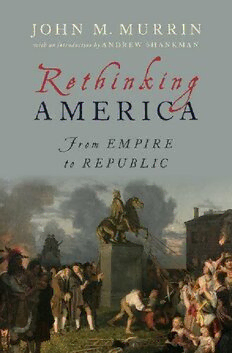
Rethinking America: From Empire to Republic PDF
Preview Rethinking America: From Empire to Republic
i Rethinking America • ii iii Rethinking America • FROM EMPIRE TO REPUBLIC John M. Murrin with an introduction by Andrew Shankman 1 iv 1 Oxford University Press is a department of the University of Oxford. It furthers the University’s objective of excellence in research, scholarship, and education by publishing worldwide. Oxford is a registered trade mark of Oxford University Press in the UK and certain other countries. Published in the United States of America by Oxford University Press 198 Madison Avenue, New York, NY 10016, United States of America. © John M. Murrin 2018 Introduction © Oxford University Press 2018 All rights reserved. No part of this publication may be reproduced, stored in a retrieval system, or transmitted, in any form or by any means, without the prior permission in writing of Oxford University Press, or as expressly permitted by law, by license, or under terms agreed with the appropriate reproduction rights organization. Inquiries concerning reproduction outside the scope of the above should be sent to the Rights Department, Oxford University Press, at the address above. You must not circulate this work in any other form and you must impose this same condition on any acquirer. CIP data is on file at the Library of Congress ISBN 978– 0– 19– 503871– 2 1 3 5 7 9 8 6 4 2 Printed by Sheridan Books, Inc., United States of America v In fond memory of Edmund S. Morgan vi vii Contents • Preface and Acknowledgments ix Andrew Shankman Introduction—The Revolutionary Republic of a Radical, Imperial, Whig: The Historical and Historiographical Imagination of John M. Murrin 1 Andrew Shankman Part I. An Overview 1. The Great Inversion, or Court versus Country: A Comparison of the Revolution Settlements in England (1688– 1721) and America (1776– 1816) 31 Part II. Toward Revolution 2. No Awakening, No Revolution? More Counterfactual Speculations 101 3. The French and Indian War, the American Revolution, and the Counterfactual Hypothesis: Reflections on Lawrence Henry Gipson and John Shy 115 vii viii viii Contents 4. Feudalism, Communalism, and the Yeoman Freeholder: The American Revolution Considered as a Social Accident (with Rowland Berthoff) 131 5. 1776: The Countercyclical Revolution 161 Part III. Defining the Republic 6. A Roof without Walls: The Dilemma of American National Identity 187 7. Fundamental Values, the Founding Fathers, and the Constitution 205 8. The Making and Unmaking of an American Ruling Class (with Gary J. Kornblith) 239 9. Escaping Perfidious Albion: Federalism, Fear of Aristocracy, and the Democratization of Corruption in Postrevolutionary America 295 10. War, Revolution, and Nation- Making: The American Revolution versus the Civil War 343 Conclusion—Self- Immolation: Schools of Historiography and the Coming of the American Revolution 383 ix Preface and Acknowledgments Andrew Shankman • I arrived at Princeton University in the summer of 1992 for my first semester of graduate school, equally eager and overwhelmed to study with John Murrin. One of my undergraduate professors, Stephen Foster, had known Murrin since their days at Yale working with Edmund Morgan. Another, Allan Kulikoff, had been Murrin’s colleague at Princeton for several years. A third, Simon Newman, had been Murrin’s student. And a fourth, Alfred F. Young, doubted Murrin’s political commitments, but confirmed what the other three said: that Murrin seemed to know everything. Murrin was, Young told me, co- writing an essay for the vol- ume Young was currently editing, an essay that Young assured me was stunning.1 Murrin, it seemed, fit well the description his Ph.D. adviser Morgan had provided for Ezra Stiles, President of Yale College from 1778 to 1795: he was “a monstrous warehouse of knowledge” exhibiting “so much energy in the sheer joy of learning.”2 That spring I had first sensed another equally important quality of John Murrin’s when I read a brief note he had written to Kulikoff and had enclosed with the final volume of the biographical dictionary Princetonians. Princetonians ran to five volumes, published between 1976 and 1991, and covered the years 1748 to 1794. Murrin’s name appears nowhere as an editor. Yet he devoted a great deal of time to the project due to his deep interest in the history of the university where he worked ix
